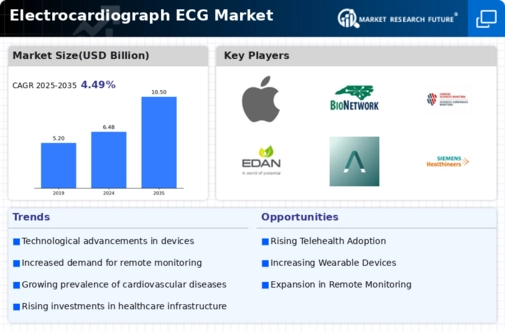Growing Geriatric Population
The aging population is a significant factor influencing the Electrocardiograph ECG Market. As individuals age, the risk of developing cardiovascular conditions increases, leading to a higher demand for ECG monitoring. The demographic shift towards an older population is evident, with projections indicating that by 2030, a substantial portion of the population will be over 65 years old. This demographic change necessitates enhanced cardiovascular care, driving the adoption of ECG technology in clinical settings. Healthcare providers are increasingly recognizing the importance of regular cardiac monitoring for elderly patients, which is likely to bolster the Electrocardiograph ECG Market. Consequently, manufacturers are focusing on developing ECG solutions tailored to meet the needs of this demographic.
Technological Innovations in ECG Devices
Technological advancements are reshaping the Electrocardiograph ECG Market, leading to the development of more sophisticated and user-friendly devices. Innovations such as portable ECG monitors and smartphone-compatible ECG applications are gaining traction among both healthcare professionals and patients. These advancements not only enhance the accuracy of cardiac assessments but also improve patient engagement in their health management. The market for wearable ECG devices is projected to expand, with estimates suggesting a compound annual growth rate that reflects increasing consumer interest. As technology continues to evolve, the Electrocardiograph ECG Market is likely to witness a surge in demand for devices that offer real-time monitoring and data analytics, thereby improving patient outcomes.
Rising Awareness of Preventive Healthcare
There is a growing awareness of preventive healthcare, which is significantly impacting the Electrocardiograph ECG Market. Patients and healthcare providers alike are recognizing the importance of early detection of cardiovascular issues. This shift towards preventive measures is leading to an increase in routine ECG screenings, particularly in high-risk populations. Educational campaigns and health initiatives are further promoting the benefits of regular heart health assessments, thereby driving demand for ECG devices. The market is expected to expand as more individuals seek proactive health management solutions. This trend indicates a potential for growth in the Electrocardiograph ECG Market, as healthcare systems adapt to meet the increasing demand for preventive care.
Increasing Prevalence of Cardiovascular Diseases
The rising incidence of cardiovascular diseases is a primary driver for the Electrocardiograph ECG Market. As heart-related ailments become more prevalent, healthcare providers are increasingly adopting ECG technology for early diagnosis and monitoring. According to recent statistics, cardiovascular diseases account for a substantial percentage of global mortality, necessitating effective diagnostic tools. This trend is likely to propel the demand for advanced electrocardiograph systems, as they play a crucial role in patient management. Furthermore, the integration of ECG devices in routine health check-ups is becoming more common, indicating a shift towards proactive healthcare. The Electrocardiograph ECG Market is thus positioned to experience significant growth as healthcare systems adapt to these changing dynamics.
Regulatory Support for Advanced ECG Technologies
Regulatory bodies are increasingly supporting the development and adoption of advanced ECG technologies, which is a key driver for the Electrocardiograph ECG Market. Initiatives aimed at streamlining the approval process for innovative ECG devices are encouraging manufacturers to invest in research and development. This regulatory support is likely to lead to the introduction of cutting-edge ECG solutions that enhance diagnostic capabilities. Furthermore, compliance with stringent safety and efficacy standards is fostering consumer confidence in these technologies. As regulatory frameworks evolve to accommodate new advancements, the Electrocardiograph ECG Market is expected to benefit from a surge in innovative products that meet the needs of healthcare providers and patients.
























Leave a Comment